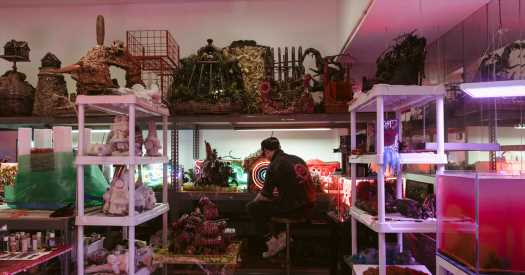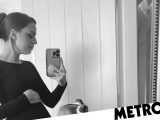
The Back Room of This Artist’s Studio Is Called the Abattoir
04/13/2023The front room of Max Hooper Schneider’s studio in Culver City, Calif., looks like the office of a taxidermist, complete with stained beige carpet, a big oak desk and ranks of animalistic mannequins and mutations. He calls the back room, where his materials are parted out and reassembled, the Abattoir.
The middle room of the studio is something else entirely — an aquarium showroom, a body shop, a hobbyist’s wonderland. Tables and stands support row after row of maquettes, sculptural environments thronged with stable and self-supporting climax communities of mass-produced objects. Bundles of plastic mushrooms glow in tinted vitrines. Dollhouse-size liquor bottles proliferate on a landscape of goo-stiffened condoms. A duo of repairmen in the San Fernando Valley sends him vintage neon tubes, in bubble gum and mustard shades they don’t make anymore; his tutor on the miniatures scene funnels him piles of tiny bottles and lamps. A fabricator outside of Belgrade, Serbia, helps him copper plate ornamental trees and roots.
There’s a metabolic metaphor here, a general law of biology at work. (Schneider has bachelor’s degrees from N.Y.U. in biology and urban design, plus a master’s in landscape architecture from Harvard.) Material enters the studio through the door, is recycled, digested and incorporated into the ecosystem. Maybe an artwork breaks off and germinates elsewhere. But Schneider would be happy to keep it all here, to stew in this constant flux of stuff. There’s life, growth and meaning everywhere. The work is frenzied, churning, excessive, “a swarm and hyperactivity of materials,” as he puts it, “that can maybe lead to engaging thought itself.”
Schneider demonstrated a sculpture in progress, in which fluorescent light bulbs dangle from the carcass of a small helicopter. Pulses arc at random from Tesla coils submerged in a pool of mineral oil, zapping at the bulbs from below. It’s a profane image of the divine touching earth, he says — like lightning striking, or a cherub adjusting a mortal’s robes.
When we met, Schneider offered that his upcoming solo show at François Ghebaly gallery is a way of reconnecting to Los Angeles after spending most of the last two years in Europe, and long stretches in Santa Fe, N.M., before that. Schneider, 40, grew up in Santa Monica, and this show is a way of touching ground.
What’s your routine? What’s your day like?
I’ll pack my lunch the night before, and then I get up and I have to do something, so I pack another lunch. I come to work with two lunches. I run six miles and get here at like 10 a.m. I’ll always have a list of things to do. And having that list necessitates the destruction of that list. So I’ll end up doing something else. If I get retinal fatigue in the studio, I’ll take a drive around town. I like doing errands because it’s a visual break from the hyperactivity of the studio. I’ll ask my friends if they want me to go do a supply run. They’re like, “What is wrong with that guy?” Like, “Where does the energy come from?” I get more energy the older I get. I mean, it could mean I’m having a nervous breakdown, but … I love the studio. I can’t wait to get here. I wake up with butterflies. Because it’s nourishing to destroy these things and then reassemble them. Then I’ll leave around 7 or 8 and go to bed. I make sure I read for an hour at the end of the day.
So that’s how long in the studio?
Nine to 10 hours a day.
What’s the worst studio you ever had?
I’ve never had a bad studio. Did you go to the first one that was so miraculous?
No!
That was at Crenshaw and Manchester, right before Inglewood blew up, before they announced the stadium and it all gentrified. I had a place that was on the second floor of a former convalescent home. It was $600 a month. It looked like every derelict habitat you’ve ever seen, in the best way. You could do whatever you wanted. If I had another project, I could just get another unit in the building and contract and expand. And then the next studio, the warehouse, was the growth spurt surrounding my project at the Hammer. [The artist’s first solo museum show opened there in 2019.] And now this. It’s only been three. I mean, I set up a studio at my mother, Barbara Hooper’s, place, in the middle of the New Mexico desert. I can do all the stuff out there that I don’t want surveilled, like gasoline fires, burying things.
What’s the first piece of art you ever made?
The first works were drawings. But I actually have the first sculpture I made, which is this electric guitar with an old towel strap.
How do you know when a piece is done?
It usually gets taken away from me. I mean, conceptually, I don’t think they’re ever done at all. But usually, the stopping point is a photo shoot.
How many assistants do you have right now?
I feel like I’m an assistant to the people that help me. You know what I mean? I try not to have assistants in house with me, but right now I have two part time. I see every season, every project almost like a garden, and everybody’s working on one plant, one monoculture or one station.
Have you assisted other artists before?
When I was finishing up my landscape architecture master’s at Harvard, I saw Pierre Huyghe’s aquariums at Marian Goodman in 2011. I was totally smitten and enraptured. Coincidentally, when I moved back to Brooklyn, his studio was there. They put out an ad. They needed an aquarium assistant. And that’s my background. So yeah, I freelanced for them, assisting with the aquariums for a couple of years until I got traction here in Los Angeles. It was the perfect finishing school. They gave me the alphabet that I was lacking going from Harvard to being an artist.
What music do you play in the studio?
I mean, I listen to death metal and black metal 24/7. It’s not even for pleasure. I’m not kidding. Like, not even a grain of salt. I’ve been listening to this since I was 8, so 32 years. It has to have changed my neural pathways and architecture.
That seems young.
Well, I had cousins who were from the Pacific Northwest, and had dirt bikes, and did drugs and were like, “You wanna be great? You gotta listen to Slayer.” You laugh, but really. It has a calming effect. It’s like sonic Ritalin. I could do heart surgery to this. You want a steady hand? It has to be blasting, you know? And then aesthetically, I like the comedic gore. I like fantasy landscapes. I like production that is not crisp, so you can actually start to put yourself into the soundscape and imagine something. There’s something nonprescriptive about it as a genre. The lyrics are usually unintelligible. I’m comfortable in that space. My work is that, dude. My work is literally a set of conditions with no plot. That’s what I want to encounter. I want the person who sees my work to feel that way, and be able to project onto it and imagine something else.
What do you usually wear when you work?
I’ve worn the same exact thing since I could dress myself. And it will never change. Whether it’s a gala or the studio or the gym. It’s sneakers and jeans and a T-shirt. I run hot and I get claustrophobic easily. So the less that’s on my body, the better. Everything’s usually black. I saved a lot of my T-shirts from high school because they’re threadbare and feel good on my skin. They’re also imbued with memories. Like, I have the same day bed that I’ve been sleeping on since I was 10. I hold on to certain things. Things have aura. I really believe in the power of materials and matter to affect your spirits, you know?
When did you first identify as an artist?
My response is gonna seem romantic, probably, because it is. I always identified as an artist. But there was a plurality of things in my life. I was disciplinarily promiscuous. I was always interested in how humans interface with and describe the world out there. So, you know, of course I’m gonna gravitate toward biology. And I was interested in architecture and landscape architecture, urban planning, because that’s another way of constructing the world out there and telling stories. But all the while, my whole life, I’ve been doing what you see in this studio.
How often do you talk to other artists?
It ebbs and flows. Sometimes you don’t want to be exposed to anything. No openings, no Instagrams, no dinner parties. I’m a protect your energy kind of guy.
What do you do when you’re procrastinating?
Material acquisition field trips or online shopping. But, I mean, this also sounds stupid romantic, but I can’t wait to get back to my sculptures. I’ll tell you another thing I love. I think writing might be one of my favorite, if not my favorite, crafts.
You’re just saying that.
I’m not kidding. I love language. But writing is something I procrastinate with. That and drawing.
What do you buy in bulk with the most frequency?
Synthetic plants. It’s insane. Plastic curios and synthetic plants. Legitimately.
What are you reading right now?
Right now I’m on a pop-science kick. A book called “Never Home Alone.” It’s about microbes. It’s funny because I’m half-germophobe, except I live in germs. And a book on platypus behavior called “Platypus Matters.” It’s a page turner.
What’s your favorite artwork (by someone else)?
No, no, no. That’s — that’s insane. The pyramids. No, I can’t answer.
What embarrasses you?
Being photographed. I hate it. I find it very embarrassing.
What’s the last thing that made you cry?
Dog dying.
That’s a good one.
Yeah, absolutely. That’s something you don’t really recover from.
I’ve been saving this one for last. What’s the weirdest object in your studio?
Ah, I know. Let me get it. Don’t move. It’s probably the most magical, most auratic. … I was in Azerbaijan on the Caspian Sea, at a flea market outside of Baku, and I found this.
It’s a military belt buckle with the faces of John, Paul, George and Ringo and a skull in the middle, and it says “the Beatles.”
Yeah. That really is so emblematic of all the simultaneity that I pursue. It’s the traumatic and the marvelous. Concurrently.
This interview has been condensed and edited.
Source: Read Full Article


